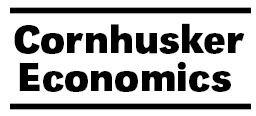Agricultural Economics, Department of

Cornhusker Economics
Date of this Version
7-6-2022
Document Type
Newsletter Issue
Citation
Cornhusker Economics July 6, 2022
Abstract
The historical causality between increased agricultural mechanization and reduction in farmlabor is a well-known relationship. The reduction in both family and hired farmworkers onU.S. f arms from 1950 to 2000 is presented in Figure 1. In 1950, the nearly 10 million farmlabor force was composed of 23.5% hired farm workers. In 2000, the last year this data wasavailable, farm labor had reduced to 3.19 million workers and was comprised of 35.4% ofthose workers being hired. The reduction in total farm workers and the trend of reduced farmlabor and a relative increase in hired farm labor appears to have stabilized during the 1990's . The contemporary inaccessibility and expense of farm labor are two factors that areinfluencing the continued adoption of labor-saving technologies in many of the ag sectors. The inaccessibility of farm labor has also been a driving factor in the steady increase of farmlabor wages. The hourly wage rate for crop, animal, and all-ag producers in the NorthernPlains region (Kansas, Nebraska, and the Dakotas), along with the national nonfarm wageand the Nebraska minimum wage from 1995-2022 are presented in Figure 2. Since 2010,wage data from the USDA Farm Labor Survey has only been available on a regional basis. Examining wage rates between Nebraska and the Northern Plains regions from 1995 to2009, showed that Nebraska farm wage rates were comparable to the Northern Plans region,with the average farm wage rates being $8.76 and $8.82 per hour, respectively, over thatperiod. A few things to note from Figure 2. First, the U.S. nonfarm wage rate has been anaverage of $6.13/hour higher than the all-ag wage rate during this period, with the wage gapexpanding over time. Second, the crop and all-ag workers’ wages have been quite similar and have outpaced the wage for livestock workers since the mid-2000's . Since 2018, the cropwage has averaged $16.51, and the livestock workers’ wage has averaged $14.93. Third,although agricultural workers are excluded from the Nebraska state minimum wage law, thereported ag wage rates have surpassed the Nebraska minimum wage since at least 1995, withthe difference continuing to widen.


Comments
Copyright © 2022 University of Nebraska-Lincoln